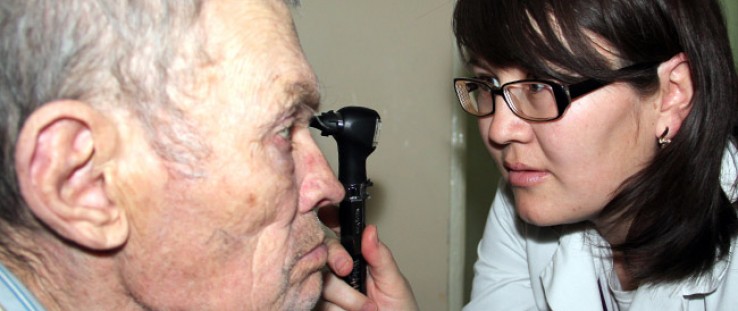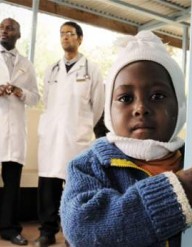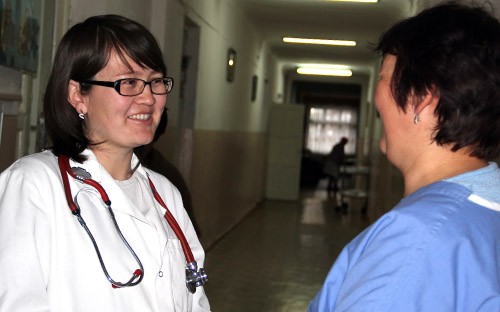 Dr. Cholpon Sadyrbaeva examines an elderly patient in Bishkek, Kyrgyzstan.
Murat Dzgergalbaev
Dr. Cholpon Sadyrbaeva examines an elderly patient in Bishkek, Kyrgyzstan.
Murat Dzgergalbaev
 Dr. Cholpon Sadyrbaeva examines an elderly patient in Bishkek, Kyrgyzstan.
Murat Dzgergalbaev
Dr. Cholpon Sadyrbaeva examines an elderly patient in Bishkek, Kyrgyzstan.
Murat Dzgergalbaev
Dr. Cholpon Sadyrbaeva flipped through her photographs on a projector screen. When she got to one showing three generations of a family that she treated in rural Kyrgyzstan, she paused and smiled. There were photographs showing her examining an infant, listening to an old man’s lungs, and counseling a middle-aged woman about high blood pressure.
The Kyrgyz State Medical Institute for Retraining and Continuing Education, USAID, and the U.S. NGO Scientific Technology and Language Institute invited Dr. Sadyrbaeva to give her presentation to dozens of sixth-year medical students at a three-day family medicine symposium in Bishkek early last November. An annual event since 2006, the symposium provides information and hands-on training to encourage more medical students to consider a career as a primary care physician.
Dr. Sadyrbaeva returned to the symposium for a second time to present her photographs and experiences to her peers. She represents a new generation of Kyrgyz family physicians that came of age and began practicing after reforms radically transformed the health-care system of post-independence Kyrgyzstan.
Weaning Off Specialists
Prior to independence, the Kyrgyz health-care system relied heavily on specialists to treat most illnesses. “Most people in Kyrgyzstan weren’t used to receiving care from a generalist and didn’t even understand the concept of family medicine, so they tended to trust specialists much more than family doctors,” Dr. Sadyrbaeva explained.
Typically, a patient would enter a health-care facility and almost immediately be referred to a specialist, even if the problem was minor. Pregnant women were required to visit three specialists. Children entering kindergarten were required to see at least five specialists and submit to numerous laboratory tests before starting school.
And most of these specialists were located in different clinics in different parts of town, adding to the time and bureaucratic hassle for patients.
When the Soviet Union dissolved and Kyrgyzstan achieved independence in 1991, the country’s health-care system was both insufficient and financially unsustainable. Mounting financial pressures on the government resulted in drastically reduced health budgets over the years.
In 1996, the Kyrgyz Government, in partnership with USAID, launched an ambitious campaign to transform and streamline the country’s health-care system. This campaign focused on broadening the scope of primary care, strengthening the capacity of providers, and establishing family medicine as the bedrock of the Kyrgyz health-care system.
“It was crucial to form a new primary health-care system with a focus on family medicine in Kyrgyzstan in the 1990s. The old system was not responsive to the patient and was collapsing under its own weight,” explained USAID health specialist Dr. Sholpan Makhmudova. “This new system is better in two ways: it reduces the size of the health sector to make better use of limited resources, and also creates space for primary health practices to expand services to more patients. A strong family medicine base is better for patients, the community, and costs less so it’s better for all.”
A major objective of the reforms was to move away from costly and often unnecessary hospital and specialist care toward more cost-efficient and patient-centered primary health care. With USAID support, the Government of Kyrgyzstan created a completely new primary health-care sector and pinpointed family practitioners—a new medical specialty that did not exist prior to reforms—as the linchpin to the new system.
Incentivizing a New Generation
For Dr. Sadyrbaeva, the choice to become a family physician was not obvious. Originally from the southern Kyrgyz city of Osh, she had dreamed of becoming a cardiologist—a prestigious and lucrative career path.
But her medical education began just as Kyrgyzstan started to implement plans to promote family medicine, including tuition assistance and monthly stipends for medical students who chose to study family medicine. The country needed to develop a new generation of family physicians—doctors who could treat a diverse array of ailments for all age groups. After carefully considering her options, Dr. Sadyrbaeva eventually decided to become a family physician.
After completing a family medicine residency in Bishkek, she served two years in a location chosen by the government in return for her financial aid. Due to a shortage of doctors, the Kyrgyz Government sent Dr. Sadyrbaeva to remote and economically distressed Naryn province. In spite of the hardships of being a doctor in a rural area, Dr. Sadyrbaeva prospered and became a skilled clinician and trusted caregiver to her patients. Within months, she was promoted to deputy director of the city’s family medicine center.
Once she finished her service in Naryn, Dr. Sadyrbaeva found work as a family physician in Bishkek.
“I work part-time as a family physician in Bishkek now, but I don’t really have a chance to practice family medicine,” she explained. “When I work in the government family clinic, the patients are divided and the pediatricians get the pediatric patients, the gynecologists get the gynecology patients, etcetera. I only get to do real family medicine when my friends and relatives ask me for advice! I hope that family practice will truly develop more here as it has in rural areas.”
Despite Dr. Sadyrbaeva’s professional success and the success of the health-care reforms that created family practitioners, the prime barrier to expanding the field remains attracting medical students. At the symposium in Bishkek, many medical students admitted that although they were interested in family medicine, they ultimately planned to become specialists because of the higher wages they offer.
In the short term, USAID is working to improve the quality of family medicine. Today, USAID, through its Quality Health Care Project, is supporting improvements in family medicine education, including the introduction of evidence-based medical standards, to produce a new cadre of capable family physicians. Over the past 15 years, USAID-sponsored programs have re-trained over 2,600 pediatricians, internists, and OB/GYNs in evidence-based family medicine.
These re-trained doctors, along with this new generation of family physicians, have positively impacted health outcomes in Kyrgyzstan over the past decade. In maternal and child health, Kyrgyzstan’s strengthened primary health-care sector has contributed to a 30-percent drop in infant mortality rates and a 35-percent drop in mortality rates for children under 5 since the start of USAID-supported health reforms.
A longer-term goal is to ensure that family medicine becomes a respected and trusted first line of health-care provision and a more attractive and prestigious career path for young doctors, and, ultimately, to help the Kyrgyz Government provide high quality and affordable health services to its people.
Through continued support from USAID and the Government of Kyrgyzstan, family medicine is steadily cementing its position in the Kyrgyz health-care system as an affordable and effective system of quality health care. Ten years ago, people chose to visit a family physician for diagnosis and treatment only 15 percent of the time. Today, as the field of family medicine has matured, people choose family physicians over specialists more than half of the time.
As more and more people go the way of family physicians, the benefit for doctors will be getting to know their patients on a more personal level. For Dr. Sadyrbaeva, her presentation at the symposium is a way to promote the profession to aspiring doctors, but it’s her smile and photographs that show the audience the affection that a family physician can have for her patients.










Comment
Make a general inquiry or suggest an improvement.